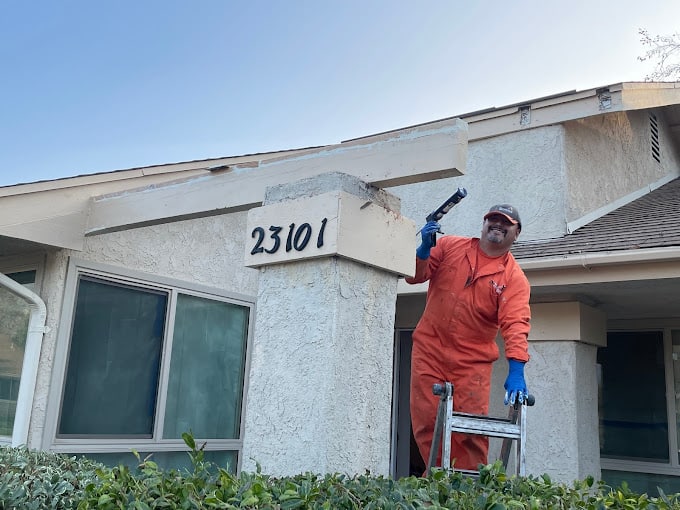Spring’s warmer weather wakes termites from winter dormancy, triggering swarms that threaten homes. These pests seek new nesting sites, often targeting structures with moisture-damaged wood or easy soil access. Unfortunately, unlike other pests, left unchecked and untreated with termite control, termite colonies can cause the most financial damage, resulting in thousands of dollars needed in structural repairs, and that’s if the damage they do can still be repaired.
Here are actionable steps that you can take as a homeowner to protect your home during this high-risk season.

Effective Prevention Strategies Against Termite Infestations
Reduce Moisture Around Your Property
Termites thrive in damp environments. Fix leaky pipes, clean clogged gutters, and direct downspouts away from foundations. Install dehumidifiers in basements or crawl spaces to maintain humidity below 50%. Avoid stacking firewood or mulch against exterior walls, as these retain moisture and attract termites.
Seal Entry Points
Inspect foundations for cracks, gaps around pipes, or loose mortar. Seal openings with silicone-based caulk or cement. Repair torn window screens and install door sweeps to block swarmers. Replace weather-damaged wood on decks, fences, or siding with termite-resistant materials like pressure-treated lumber or metal.
Use Orange Oil
For existing homes, non-repellent treatments create invisible shields. Orange oil, derived from citrus peels, offers a plant-based alternative. It penetrates wood, eliminating drywood termites without disrupting daily life. This method works well for localized infestations but may require professional application for larger colonies.
Landscape Mindfully
Keep shrubs, trees, and vines trimmed away from structures. Overgrown vegetation creates shaded, moist areas that termites favor. Use gravel or stone barriers instead of mulch near foundations. Maintain at least an 18-inch gap between soil and wooden structures to deter subterranean termites.
Schedule Professional Inspections
Annual inspections in early spring catch swarms before colonies form. Technicians use advanced tools to assess risk levels, including damp zones, and other tools to detect the most subtle signs of active colonies.
A Step-by-Step Breakdown of the Termite Inspection Process
Termite inspections are thorough. They can last anywhere between 1-2 hours, depending on property size.
Here’s how professional termite experts make sure that no termite goes unnoticed:
1. Exterior Inspection
Technicians examine foundations, siding, and landscaping. They probe soil around the perimeter for mud tubes and check wooden structures like decks or fences for damage. Crawl spaces and attic vents are inspected for swarmers or frass.
2. Interior Inspection
Every room is scrutinized, focusing on moisture-prone areas like basements, bathrooms, and kitchens. Walls are tapped to detect hollow sounds, and floors are checked for buckling.
3. Report and Recommendations
Homeowners receive a detailed report with photos of findings. Professionals will also provide cost estimates and timelines for better transparency.
4. Follow-Up Plans
For active infestations, professionals schedule immediate treatment. For preventive care, seasonal maintenance is a must. Quarterly monitoring station checks can prevent termite infestations from taking hold.
Long-Term Benefits of Spring Termite Control
Prevents Structural Damage
Termites silently eat support beams, flooring, and insulation. Early detection and treatment preserve your home’s integrity, avoiding costly repairs.
Saves Money
Addressing swarms in spring reduces the need for extensive extermination later. The National Pest Management Association estimates termites cause over $5 billion in annual property damage—preventive care slashes these costs.
Protects Health
While termites don’t transmit diseases, infestations worsen allergies by dispersing frass and mold spores. Eliminating colonies improves indoor air quality.
Maintains Property Value
Homes with termite histories often require disclosures during sales, lowering resale value. Proactive control keeps records clean, reassuring potential buyers.
Long-Term Strategies for Lasting Termite Protection
Protecting a home from termites isn’t a one-time task. Maintain a consistent prevention routine by trimming overhanging branches that create shade and moisture. Choose termite-resistant materials like pressure-treated lumber or metal framing for renovations. Educate yourself about local termite species. Basically, what we’re trying to say is to stay proactive even after treatment.
If you live in a community with high termite activity, you can ask your neighbors if you can all combine your efforts to fight against these annoying pests, reducing overall risks and costs.
Regular Inspections Can Save Your Home
Termites operate silently, often causing damage long before detection. Schedule annual inspections with licensed pest control experts. In regions prone to infestations, monitoring systems provide ongoing protection. These devices attract termites then eliminate entire colonies through slow-acting agents. Early intervention minimizes repair costs and preserves structural integrity.
But if you notice swarms appearing indoors at your home, don’t disturb them. Collect a sample for identification and call an expert immediately. They’ll give you a list of options to use for your particular case, letting you choose between localized and targeted treatments and last-resort options in case the infestations are too severe and intensive.
Remember, termite management is an ongoing process. Stay alert, stay informed, and your wallet will be safe from termite infestations.































